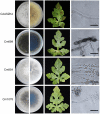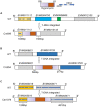Identifying pathogenicity-related genes in the pathogen Colletotrichum magnum causing watermelon anthracnose disease via T-DNA insertion mutagenesis
- PMID: 37547676
- PMCID: PMC10399754
- DOI: 10.3389/fmicb.2023.1220116
Identifying pathogenicity-related genes in the pathogen Colletotrichum magnum causing watermelon anthracnose disease via T-DNA insertion mutagenesis
Abstract
Fruit rot caused by Colletotrichum magnum is a crucial watermelon disease threatening the production and quality. To understand the pathogenic mechanism of C. magnum, we optimized the Agrobacterium tumefaciens-mediated transformation system (ATMT) for genetic transformation of C. magnum. The transformation efficiency of ATMT was an average of around 245 transformants per 100 million conidia. Southern blot analysis indicated that approximately 75% of the mutants contained a single copy of T-DNA. Pathogenicity test revealed that three mutants completely lost pathogenicity. The T-DNA integration sites (TISs) of three mutants were Identified. In mutant Cm699, the TISs were found in the intron region of the gene, which encoded a protein containing AP-2 complex subunit σ, and simultaneous gene deletions were observed. Two deleted genes encoded the transcription initiation protein SPT3 and a hypothetical protein, respectively. In mutant Cm854, the TISs were found in the 5'-flanking regions of a gene that was similar to the MYO5 encoding Myosin I of Pyricularia oryzae (78%). In mutant Cm1078, the T-DNA was integrated into the exon regions of two adjacent genes. One was 5'-3' exoribonuclease 1 encoding gene while the other encoded a WD-repeat protein retinoblastoma binding protein 4, the homolog of the MSl1 of Saccharomyces cerevisiae.
Keywords: ATMT; Colletotrichum magnum; T-DNA integration; fungal transformation; virulence gene.
Copyright © 2023 Guo, Wu, Peng, Kang, Liu, Luo and Gu.
Conflict of interest statement
The authors declare that the research was conducted in the absence of any commercial or financial relationships that could be construed as a potential conflict of interest.
Figures





Similar articles
-
Identification of pathogenicity-related genes in the rice pathogen Ustilaginoidea virens through random insertional mutagenesis.Fungal Genet Biol. 2015 Mar;76:10-9. doi: 10.1016/j.fgb.2015.01.004. Epub 2015 Jan 28. Fungal Genet Biol. 2015. PMID: 25636735
-
Identification of virulence genes in the crucifer anthracnose fungus Colletotrichum higginsianum by insertional mutagenesis.Microb Pathog. 2013 Nov;64:6-17. doi: 10.1016/j.micpath.2013.06.001. Epub 2013 Jun 24. Microb Pathog. 2013. PMID: 23806215
-
Cloning of insertion site flanking sequence and construction of transfer DNA insert mutant library in Stylosanthes colletotrichum.PLoS One. 2014 Oct 31;9(10):e111172. doi: 10.1371/journal.pone.0111172. eCollection 2014. PLoS One. 2014. PMID: 25361073 Free PMC article.
-
Transformation of Corynespora cassiicola by Agrobacterium tumefaciens.Fungal Biol. 2019 Sep;123(9):669-675. doi: 10.1016/j.funbio.2019.05.011. Epub 2019 May 30. Fungal Biol. 2019. PMID: 31416586
-
A silver bullet in a golden age of functional genomics: the impact of Agrobacterium-mediated transformation of fungi.Fungal Biol Biotechnol. 2017 Sep 26;4:6. doi: 10.1186/s40694-017-0035-0. eCollection 2017. Fungal Biol Biotechnol. 2017. PMID: 28955474 Free PMC article. Review.
References
-
- Casado-Del Castillo V., Maccabe A. P., Orejas M. (2021). Agrobacterium tumefaciens-mediated transformation of NHEJ mutant aspergillus nidulans conidia: an efficient tool for targeted gene recombination using selectable nutritional markers. J. Fungi 7:961. doi: 10.3390/jof7110961, PMID: - DOI - PMC - PubMed
-
- Chauhan A., Modgil M., Rajam M. V. (2021). Establishment of Agrobacterium tumefaciens - mediated genetic transformation of apple pathogen Marssonina coronaria using marker genes under the control of CaMV 35S promoter. Microbiol. Res. 253:126878. doi: 10.1016/j.micres.2021.126878, PMID: - DOI - PubMed
LinkOut - more resources
Full Text Sources
Research Materials

